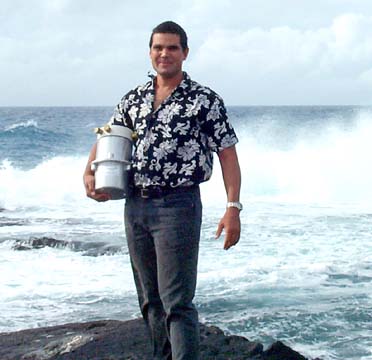


|
UH lab in In a dense tropical forest in Kona, a listening post designed to detect nuclear explosions is picking up sounds of meteors and storms, even surf slapping against cliffs, thousands of miles away.
Kona listens to
Earth’s noisy events
The station can detect phenomena
taking place worldwideBy Helen Altonn
haltonn@starbulletin.comThe University of Hawaii-Manoa Infrasound Laboratory is the first certified station in an International Monitoring System that eventually will have 60 stations recording sounds around the globe, said UH physicist Milton Garces, scientific director of the Kona facility. His four-member team will install and operate four more stations in the next two years in the Pacific and Indian oceans.
Garces said that when he came here in 1997, he knew one station in a system to monitor clandestine nuclear tests was to be built in Hawaii. He made some phone calls and ended up breaking ground for a station in December 1999.
It began collecting data in June 2000 on severe weather systems from Antarctica to Alaska, Pacific meteor impacts and other events.
Signals are sent to an array of four microphones acting like an antenna in the radio tower.
Hurricane Daniel was heard approaching Hawaii in July last year before it was even designated a hurricane, Garces said.
In August 2000, the laboratory detected a giant meteor that burst off Mexico's coast, and another one in April that exploded between California and Alaska, he said. They had the explosive strength of thousands of tons of TNT.
"Bright light meteors and storms are the main things," he said. But a lot of interesting local events also are picked up, he said, such as "all kinds of aircraft flying around."
"Half of our detection is associated with surf on the West Coast from various directions."
Volcanic activity on the Big Island and elsewhere is being monitored, and the listening network will be part of the International Volcano Alert System to protect aircraft from volcanic plumes.
Volcanoes, meteors, storms and clandestine nuclear tests produce low-frequency sound waves or infrasonic waves, that cannot be heard with the human ear but can be detected from thousands of miles away.
The signals are encrypted and sent by satellite to the International Data Center in Vienna, Austria, and via the Internet to a U.S. data center in Arlington, Va.
He said the scientists followed the fluid dynamics of the Big Island in choosing a laboratory site on Kamehameha Schools land on the mountain slopes, leeward of three volcanoes.
The island is unique, he explained, because "not many tropical areas are completely protected from tradewinds. We found little pockets protected from wind, the main source of noise, and looked for roads that will take us there."
During a workshop in Kona last month, about 60 international scientists visited the station to discuss technical issues with the monitoring system.
Among them was Henry Bass of the University of Mississippi, director of the Global Infrasound Network Consortium. "For us in the field, it's an extraordinary time," he said.
He said it is difficult to convey the scientists' excitement at being able to listen to such things as giant meteors entering the Earth's atmosphere with large explosions.
"Never before have we had the opportunity to listen to sounds of the planet across the planet at one time. For us, it's sort of like the first time a satellite goes up in space and looks down from above.
"This is very analogous to that. We're going to be able to hear hurricanes and volcanoes long before we see them. We just don't know what else we will hear."
California's station was finished soon after Hawaii's and Alaska is completing one, Bass said. It is hoped to have 25 of the 60 planned stations operating by the end of next year.
"It takes a long time. Many are in very remote places of Earth," he said, explaining they must meet detection capabilities specified by international agreement.
The United Nations Provisional Technical Secretariat provides about half the money for the stations, and the other half is provided by U.S. agencies interested in the project such as the Defense Department, Bass said.
"It's a very new science and as yet no federal agency has the responsibility for providing or overseeing funding or championing the cause."